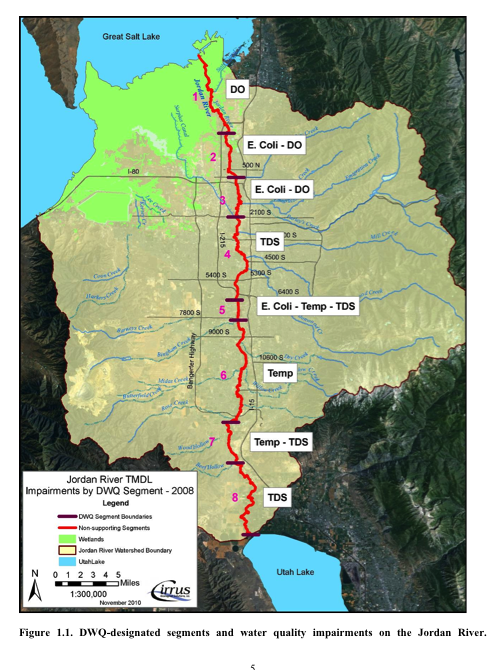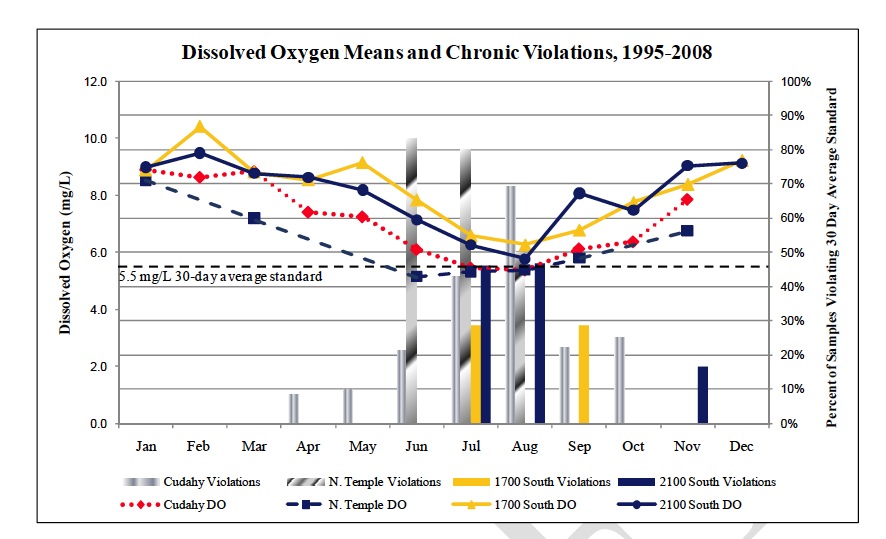UTAH DEPARTMENT OF ENVIRONMENTAL QUALITY
Executive Summary
This water quality study for the Jordan River establishes the Total Maximum Daily Load (TMDL) for Total Organic Matter (OM) of 3,983 kg/day that will achieve the model endpoint for Dissolved Oxygen (DO). This target concentration is defined in a water quality model (QUAL2Kw) which is being used as a decision support tool for restoring beneficial use to the lower Jordan River. Additional testing was conducted to quantify uncertainty of input parameters and rates used in the calibrated model. Based on these results and additional information reviewed during the TMDL process, a 1.0 mg/L implicit Margin of Safety (MOS) was added to the Jordan River instantaneous DO standard of 4.5 mg/L. Input concentrations of Total OM that resulted in meeting the model endpoint of 5.5 mg/L DO were used to define permissible loads to the lower Jordan River. This model endpoint and the resulting permissible loads account for levels of uncertainty that exist in the TMDL process at this time and are designed to maintain DO levels in the lower Jordan River above the instantaneous DO standard.
The five chapters in this report meet EPA requirements for a TMDL water quality study.
Chapter 1 describes the justification for this TMDL water quality study and the physical and social conditions in the Jordan River watershed that influence existing and future water quality conditions.
The Jordan River is a relatively short river, approximately 51 miles long, originating at Utah Lake and flowing north to terminate in wetlands that eventually discharge to the Great Salt Lake. The topography within the Jordan River watershed contributes to a very complex precipitation pattern with great variability in amounts and timing of flows. Although Utah Lake is the single largest source of flows to the Jordan River, much of this water is diverted within a few miles for agricultural and municipal use. Other tributaries flow into the Jordan River from both east and west, but these, too, are subject to a complex network of diversions, return flows from canals, stormwater discharge, and exchange agreements between culinary and agricultural users. The lower Jordan River begins downstream of the largest diversion, the Surplus Canal, which redirects up to 90 percent of the flow from the Jordan River directly to the Great Salt Lake to protect neighborhoods and developments from flooding.
Designated beneficial uses for the various segments of the Jordan River include domestic uses (with prior treatment), secondary contact recreation (boating, wading, fishing, etc.), cold and warm water fisheries, other wildlife that depend on an aquatic environment (waterfowl, shorebirds, and the aquatic organisms in their food chains), and agricultural irrigation. These uses are protected by a variety of water quality standards, but every segment of the Jordan River has been found to be non-supporting of one or more beneficial uses (i.e., impaired) due to exceeding one or more of these water quality standards.
Violations of two of the water quality standards, temperature and Total Dissolved Solids (TDS), are largely due to natural causes, including shallow water, hot summer air temperatures, and ground water high in natural thermal discharges and TDS. A separate analysis of these factors is being undertaken that may include proposals for site-specific criteria. Only the lower Jordan River downstream of the Surplus Canal (north of 2100 South in Salt Lake City) is listed as impaired for Dissolved Oxygen (DO), a critical condition for many aquatic species. The pollutant of concern, linkages between that pollutant and DO, sources of loading, and a load allocation that will resolve the DO impairment, are the subject of this TMDL study.


Download Full Study (PDF): Jordan River TMDL Water Quality Study
The Utah Department of Environmental Quality Mission Statement
www.deq.utah.gov
“To safeguard public health and our quality of life by protecting and enhancing the environment. We implement State and federal environmental laws and work with individuals, community groups, and businesses to protect the quality of our air, land and water.”
Tags: Environmental Study, Jordan River, Utah, Water Quality






 RSS Feed
RSS Feed